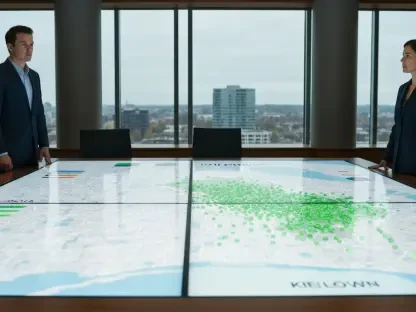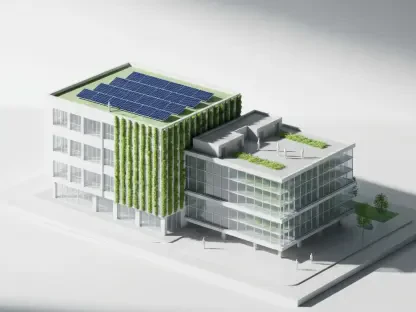In the realm of sustainable architecture, a significant development has emerged with the resurgence of thatch—a traditional building material crafted from plant materials like reeds and straw. This material, once overshadowed by modern methods, is gaining attention for its environmental advantages, including excellent insulation properties and carbon sequestration capabilities. As architects and builders increasingly turn to eco-friendly solutions, thatch reappears as a sustainable option deeply rooted in historical architecture practices, offering both ecological and cultural benefits. Several pioneering projects exemplify the innovative application of thatch, serving as beacons of sustainability in contemporary architectural design.
A Historic Material with Modern Relevance
Cross-Cultural Collaboration: The Houseboat Challenge
The Houseboat for Ho, situated in Denmark’s Wadden Sea National Park, embodies modern eco-conscious building. British artist Simon Starling crafted this unique project, using reeds in its construction to raise awareness about environmental crises like rising sea levels and wetland destruction. The houseboat showcases reeds’ dual role in carbon sequestration and wetland preservation. Starling’s collaboration with South American reed boat builders from Lake Titicaca enriches the project, blending traditional knowledge with contemporary ecological issues. This cross-cultural approach to architecture exemplifies how the ancient material of thatch can address today’s pressing environmental challenges.
Moreover, this thatched houseboat highlights the critical role of wetlands, vital ecosystems with extensive biodiversity that face significant destruction globally. Wetlands are crucial carbon sinks, contributing to global climate regulation. The project emphasizes the potential of reeds, not just as a building material but as an active participant in preserving these invaluable ecosystems. The Houseboat for Ho artfully connects traditional craftsmanship and modern sustainability efforts, prompting reflection on how traditional construction methods can provide solutions to contemporary environmental dilemmas. Its success inspires further exploration of how traditional materials can contribute to eco-friendly architectural practices.
The Practical Advantages of Reeds
Reeds offer remarkable practical benefits, enhancing their appeal in sustainable architecture. Their high silica content makes them naturally resistant to water and fire, crucial for durable building materials. However, the widespread adoption of manufactured materials during the industrial revolution led to the decline of thatch use, severely impacting wetland ecosystems. The alarming deterioration of these ecosystems over the past centuries highlights the urgency for preservation, as wetlands are indispensable for ecological balance and carbon storage. The destruction of half of the wetlands in Europe and the continental US, coupled with the loss of up to 75% of wetlands in the UK, underscores the environmental consequences of ignoring these natural habitats.
As architects reinvigorate interest in thatch, the material’s inherent qualities offer promising solutions to modern problems. Its resilience against water and fire positions reeds as a viable and sustainable building material. The environmental crisis invites a return to traditional Indigenous knowledge and practices that recognized the environmental benefits of using such materials. By embracing thatch and reeds anew, architects can actively participate in restoring wetlands while offering innovative design solutions that integrate building efforts with conservation goals. This shift not only revitalizes cultural heritage but also aligns architectural practices with urgent environmental conservation efforts.
Aesthetic and Functional Integration
Bridging Tradition and Innovation: The New Architectural Styles
Architects like Arjen Reas in Rotterdam are spearheading the reintegration of thatch into modern architecture, exploring innovative designs that seamlessly blend reeds with contemporary aesthetics. Reas positions thatch as an incredible “warm coat” for homes, harmoniously connecting buildings to their natural surroundings. This aesthetic approach fosters occupants’ connection to nature, as they can view the reed material from indoors, establishing a refuge that resonates deeply with the environment. Reas commonly incorporates thatch into roofs and walls, resulting in structures that are not only captivating but also energy-efficient due to superior insulation properties.
Despite the initial costs being higher than conventional materials, the long-term benefits of thatch in reducing energy consumption by stabilizing indoor temperatures offer financial incentives over time. This transition towards sustainable materials represents a transformative approach in architectural design, where aesthetics, functionality, and responsibility merge. Architects’ adherence to sustainable goals transforms landscapes and enlivens traditional materials, demonstrating that the marriage of style and sustainable practices can generate enriching living spaces and ecological benefits.
Challenging Stereotypes: Reliability Revisited
Architect Ádám Reisz of RAPA challenges preconceived notions about thatch’s dependability through projects around Hungary’s Lake Balaton. Despite skepticism about its reliability, Reisz demonstrates that with adequate maintenance, a thatched roof can endure for decades, underscoring the material’s long-term viability. The innovative designs around Lake Balaton stimulate new interest in utilizing thatch, proving that traditional materials can successfully find their place in modern architectural endeavors. By refuting stereotypes associated with traditional materials, Reisz strengthens thatch’s credibility while promoting sustainable design practices that honor cultural heritage.
These designs illustrate how embracing traditional techniques can overcome biases linked with older materials, educating future generations on the durability and ecological benefits of such methodologies. Reisz’s venture dispels myths surrounding thatch, encouraging its acceptance and integration into contemporary building practices. This move signifies broader possibilities for eco-friendly architecture, where materials of the past can become cornerstones for future design innovations, driven by an overarching commitment to sustainability.
Addressing Contemporary Challenges
Fire Safety and Insurance: Techniques and Innovations
While thatch offers environmental benefits, concerns remain about fire safety in thatched buildings. Despite reeds’ natural fire resistance due to their silica content, misconceptions persist regarding their flammability compared to materials like slate. Architects like Reas address these perceptions by employing construction techniques that minimize air pockets, thus reducing fire risks significantly. Danish innovations in fire safety, such as spraying thatch with inflammable clay, illustrate proactive measures to bolster fire resistance and ensure the insurability of thatched structures.
These technical advancements in construction practices pave the way for embracing traditional materials without compromising on safety standards. Reevaluating traditional building materials reflects a dynamic shift, assuring builders and insurers that such structures meet modern requirements while retaining their ecological and aesthetic attributes. By fostering innovation in architectural safety and viability, the sustained use of thatch promises ecological benefits, urging architects and builders to explore its possibilities more deeply.
Eco-Conscious Waterproofing: Rethinking Material Use
A common critique of thatch concerns its reliance on petrochemical-based materials for enhanced waterproofing, which counters its eco-friendly purpose. However, innovative architects like Robert van der Pol and LMNL Office for Architecture and Landscape challenge this norm by crafting breathable structures without non-biodegradable barriers. This commitment to preserving the authenticity of traditional thatch practices aligns with creating healthier living environments, benefitting inhabitants and the earth. Their house, Veldhuis, exemplifies this approach by pairing thatch with renewable materials like cross-laminated timber and wood fiber insulation, enabling a seamless union with nature.
Such architectural efforts elucidate that sustainability does not necessitate compromising tradition or innovation. By prioritizing materials that promote breathability and environmental harmony, architects reinvigorate the essence of traditional design principles while accommodating modern expectations of performance and aesthetics. These sustainable construction techniques emphasize rethinking conventional barriers and encapsulate the promise of enhancing architectural practices in favor of ecological stability and innovation.
Sustaining Knowledge and Craftsmanship
Mastery of Craft: Preserving Traditional Knowledge
The revival of thatch in architecture heavily depends on the expertise of master thatchers, whose skills have been passed down through generations. This specialized knowledge enriches architectural projects but poses challenges where such mastery has diminished or is absent. To overcome these obstacles, innovative approaches are being devised, enabling the utilization of reeds and straw in construction without extensive expertise. Material Culture’s prototype building in London exemplifies this strategy, blending traditional materials with contemporary methods to create structures accessible to less skilled builders.
Material Culture’s efforts spotlight the significance of collaborative knowledge transfer, where design and construction become instrumental in nurturing relationships with the land. Their project at Pasteur Gardens in London exemplifies this philosophy, with walls composed of straw and clay, clad in reed bundles, complemented by a corrugated metal roof—a testament to simplicity, sustainability, and durability. Institutions and architects thus foster a culture of inclusion in architectural practices, ensuring that environmentally conscious methods are both innovative and accessible to broader audiences.
Expanding Research and Education: A Global Vision
The endeavors of Material Culture extend beyond construction, engaging with bio-regional methods and regenerative agriculture to enhance sustainable practices. Their research fieldwork in Brandenburg, Germany, investigates responsible wetland farming to source renewable construction resources and rehabilitate peatlands. This vital research underpins their work at London’s Wellcome Collection, which hosts the exhibition Thirst: In Search of Fresh Water. This exhibition emphasizes fresh water’s significance and wetlands’ role in supporting a global ecological equilibrium.
Their commitment to research and education embodies a broader vision of sustainability, enriching architectural practices and promoting innovative methods for ecological balance. Through exhibitions and academic research, architects and researchers inspire collective responsibility and innovative solutions, fortifying wetland preservation and embodying sustainability in architecture for future generations. This expansive dialogue encourages exploration and emphasizes that environmentally conscious building is essential for ecological restoration, mindfulness, and cultural heritage appreciation.
Pathway to Sustainability
In the sphere of sustainable architecture, a noteworthy trend has emerged with the revival of thatch—a traditional building material made from natural elements like reeds and straw. Once eclipsed by modern construction techniques, thatch is now recognized for its environmental benefits, including superior insulation and its ability to sequester carbon, thus reducing the carbon footprint of buildings. As more architects and builders shift towards eco-friendly solutions, thatch finds renewed relevance, drawing on historical architectural practices that offer both ecological and cultural advantages. This resurgence highlights a blend of tradition and innovation, exemplified in numerous pioneering projects that demonstrate the clever use of thatch. Acting as symbols of sustainability in contemporary design, these projects illustrate how ancient materials can satisfy modern demands for eco-conscious construction, thereby enriching both the environment and our architectural heritage.









